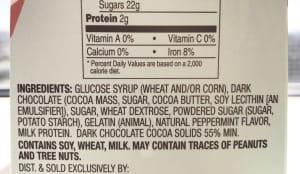
Understanding Food Labels
All people with a food allergy should be taught by a registered dietitian, nutritionist or other clinician to read food labels and avoid offending foods.
If your child has a food allergy, it is very important that you read all packaged food labels to protect your child from eating food allergens until he or she is old enough to read labels responsibly. Reading food labels may seem like common sense, but packaged and mixed foods like cereals, bars, candy, baking mixes and frozen entrees can actually have a very long ingredient list—with food items you’d never expect. Reading the ingredients can be daunting and confusing. Here’s what you need to know to decode food labels!
The Food and Drug Administration (FDA) is the organization in charge of food labels—and the U.S. Food Allergen Labeling and Consumer Protection Act (FALCPA) is the law that regulates these labels. This law came into effect in 2006.
While many different foods can cause a food allergy, there are eight foods that cause 90 percent of all food allergies in the U.S.:

- Milk
- Soy
- Wheat
- Eggs
- Peanut
- Tree nuts
- Fish
- Shellfish
FALCPA states that these eight foods have to be written in clear, plain language. This means that if a cereal bar contains an ingredient such as the milk protein, whey, it must be written clearly in the ingredient list that the whey came from milk. There are two ways that FALCPA allows ingredient lists to indicate food sources:
- Using parentheses inside the list of ingredients, i.e. “Triticale (Wheat)”
- Immediately after the ingredients list, using the word “contains” followed by the name of the major food allergen, e.g. (Contains: Wheat)
FALCPA applies only to certain foods:
- All packaged foods sold in the United States, whether they are manufactured in the U.S. or imported.
- Food sold at all retail and food-service establishments. This includes any foods for sale in vending machines and all packages labeled “for individual sale.”
FALCPA does not apply to:
- Fruit, vegetables, meats, poultry and certain egg products, which are regulated by the U.S. Department of Agriculture (USDA)
- Any restaurant food (including street vendors, festival foods and fast-food restaurants) that are placed in a wrapper or container in response to a person's order for that food
- Highly refined oils (even if derived from one of the eight major food allergens)
- Prescription and over-the-counter drugs
- Personal care items such as cosmetics, shampoo, mouthwash, toothpaste or shaving cream
- Alcohol and tobacco products
- Kosher labeling
- Pet foods, supplements and supplies
Cross Contact Warnings
Many products now contain cross contact warnings, such as “May contain nuts” or “Processed in a facility with equipment that also processes peanuts and tree nuts.” Food labels are not required to declare allergenic ingredients introduced through cross contact; companies have started to do this as a courtesy and to limit their own liability.
Let’s say your child is allergic to peanuts, and you carefully read the ingredient label of packaged chocolate ice cream, and no peanuts are listed. But, after the ingredients list, there is a separate statement that reads, “Made on equipment that also processes peanuts.” Can your child safely eat the chocolate ice cream? As these statements are not standardized, it’s best if you discuss this with your child’s allergist.
Follow these simple steps to avoid accidental allergen exposure:
- Read food labels—every label, every time you shop.
- Contact the food company when in doubt.
- Avoid any food or product if you are uncertain.


